By Paul Jacobs & Tom McDonald
The Voyage
The first hint that the weather forecast would not prove especially accurate soon occurred on the first leg. The marine forecast called for 7-10 knots out of the west, which would have resulted in a lovely starboard tack beam reach down the Hudson. However, we departed the Minisceongo Yacht Club in a near calm, and about two hours later as we motorsailed under the Tappan Zee Bridge the wind was out of the north at only 3-4 knots. Nonetheless, on the first of May we could hardly complain as it was sunny and about 60 degrees.
As we approached the George Washington Bridge, Paul had a moment of intense nostalgia. As a small child four score years ago,
I grew up in nearby Washington Heights, in an apartment building on 187th Street, six blocks NE of the bridge. Long past but vivid memories of Boy Scout hikes exploring the little red lighthouse at the base of the bridge, walking across the bridge itself, and overnight camping in New Jersey remain etched in my brain, and yet here we were sailing under that venerable old bridge a lifetime later.
There was substantial commercial traffic both north and south bound on the Hudson, so to avoid possible issues we hugged the New Jersey side of the river. Evidently, we hugged it a bit too well, as somewhere abeam about 65th Street we ran aground! In the middle of the Hudson River! We tried the engine in forward. Stuck in the mud! We tried the engine in reverse. Still stuck! We tried throwing her Danforth anchor to port to kedge off. Still stuck! We called both Sea Tow and Sea Safe, and to our dismay in NYC, on a sunny Sunday in May, one told us he would not come at all, and the other said he could not make it for at least four hours! After two hours the tide filled, we floated off the bottom, and resumed our voyage to Hudson Point Marina in Jersey City, New Jersey, passing the giant Colgate clock at
6:55 pm.
After furling the jib, dropping, flaking, and securing the mainsail, and putting out fenders, we slowly powered to our reserved slip. About six people on the dock were intently observing us. One asked, “What is that lovely little sailboat?” Our first compliment – and her restoration had barely begun.
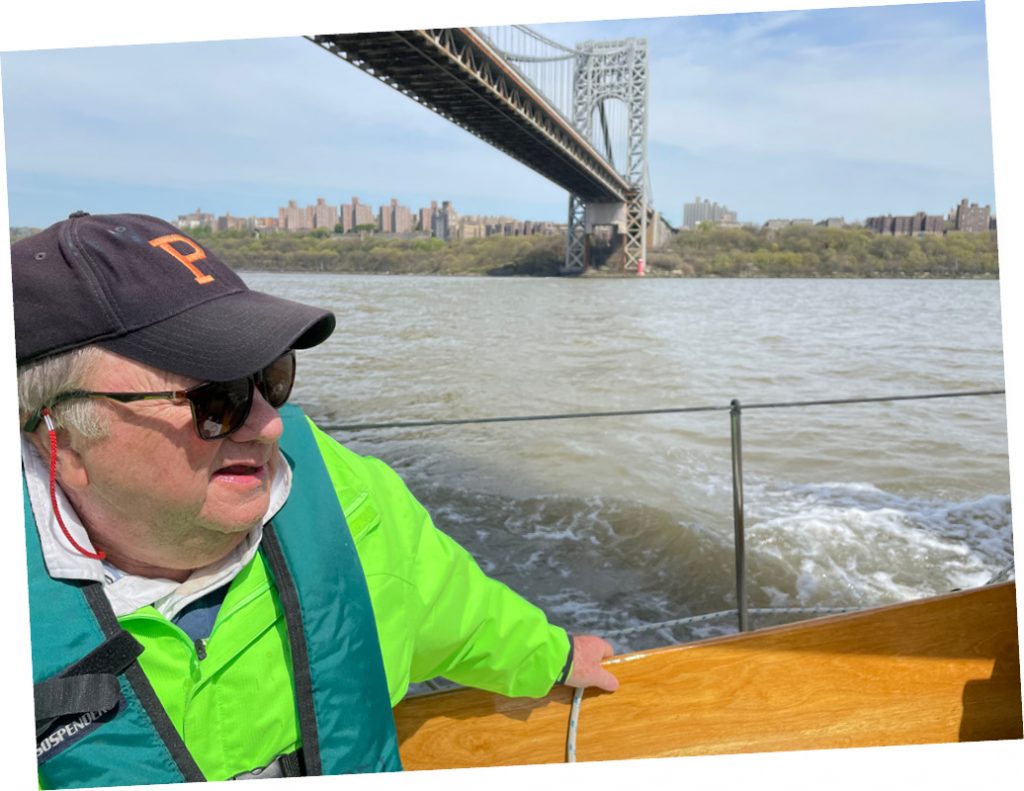
Paul Jacobs at the tiller of the GC, sailing under the George Washington Bridge. The barely visible little red lighthouse at the base of the bridge, the GW Bridge itself, and PJ are all still
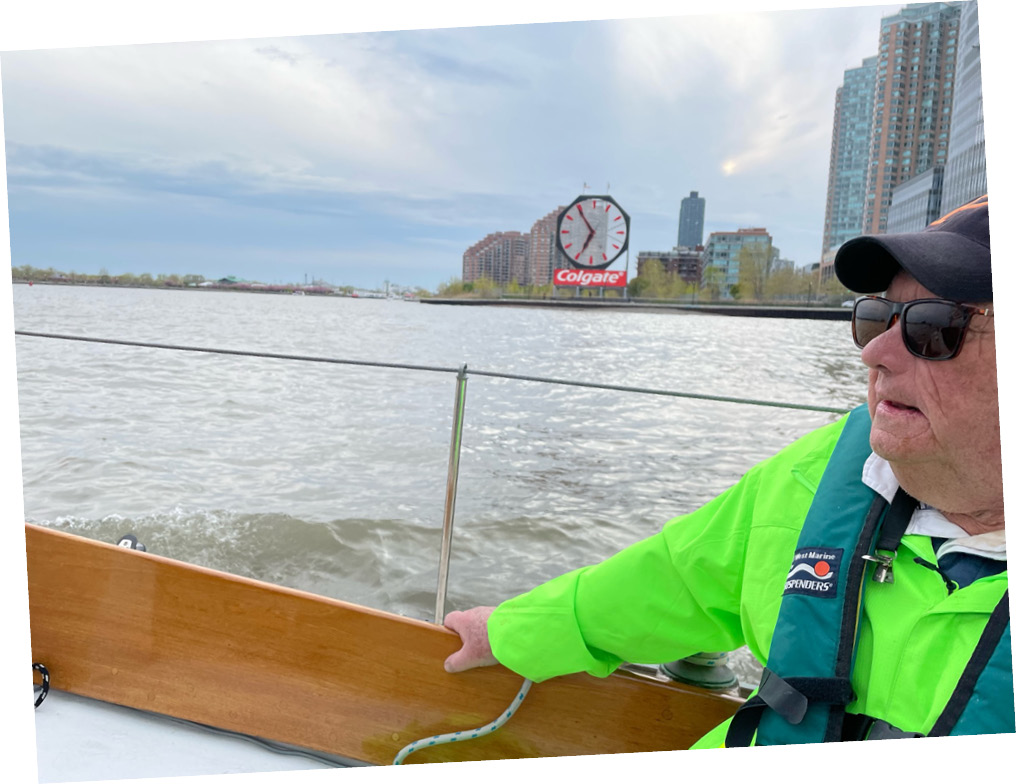
Approaching Hudson Point Marina, Jersey City, NJ
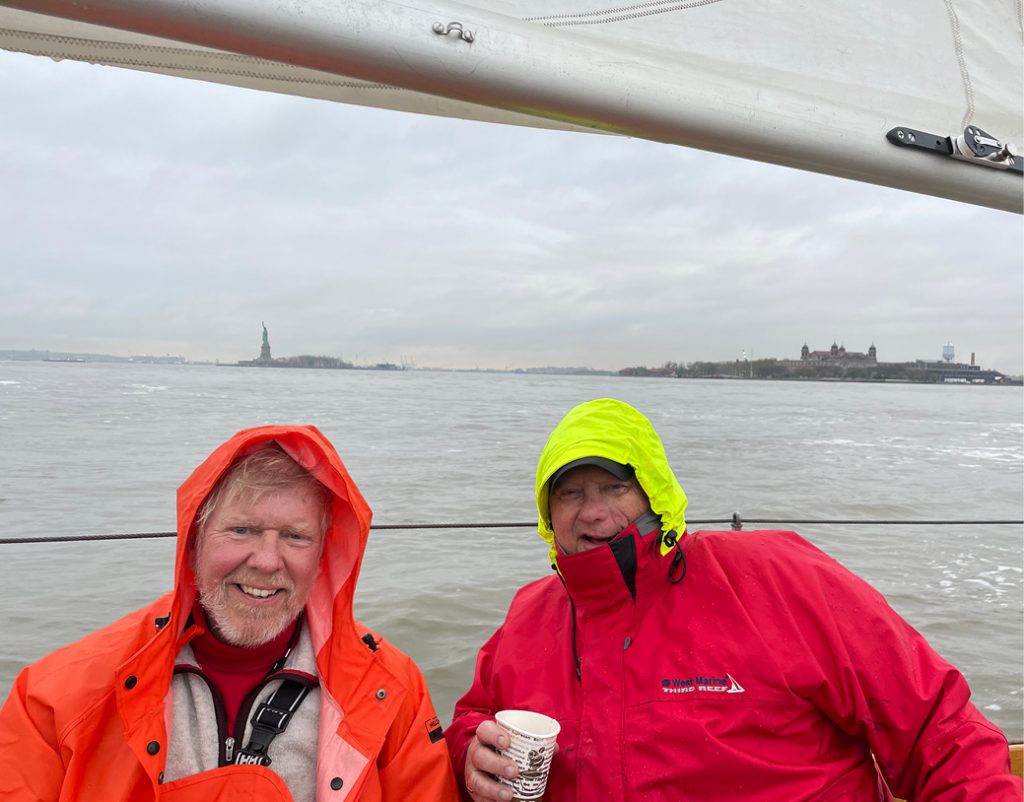
Tom, Paul, and a distant Lady Liberty
The forecast called for a partly cloudy evening. So naturally, it started to rain. We asked the locals about a nice place to eat dinner, and they directed us to The Light Horse Tavern about five blocks away. The food was terrific, the atmosphere warm and friendly colonial style, and although we were dressed in sailing attire, no one there seemed to mind. Eventually we wandered back to the marina in a light rain, and three full-sized sailors snuggled into a tiny cabin – Tom in the V-berth, John in the starboard salon bunk and Paul in the port salon bunk. Tom set his mobile phone alarm for 7 am. We all slept like we were drugged.
On the morning of May 2 we awoke, found some coffee, and Tom and I each took our multiplicity of pills, and with John we three motored out of the marina, unfurled the jib, raised and trimmed the main, and headed for The Battery in a light drizzle with multiple tugboats, barges, ferries, and other commercial and pleasure powerboats whizzing about in various directions.
We detoured five times to avoid even the most remote possibility of a collision, and finally rounded The Battery only five minutes after optimum. We soon zoomed under the Brooklyn, Manhattan, and Williamsburg bridges at about 8 knots, with a roughly 3-knot favorable current.
Shortly thereafter we actually accelerated! Going under the Queensboro Bridge alongside Roosevelt Island we hit 8.5 knots, and finally a maximum speed of 9 knots over the bottom as we passed through Hell’s Gate, documented on our newly installed Simrad GPS chartplotter.
Some dramatic eddies drew our collective concern as the Graves Constellation only has about two feet of freeboard amidship, but nary a drop of the East River ever came aboard. All three of us were smiling and laughing as this – presumably the worst part of the voyage – was now behind us. We soon passed under the Bronx-Whitestone Bridge.
However, as is so true of many aspects of life, beware of hubris! One disquieting aspect was that even the current marine weather forecast was still calling for 8 -12 knots out of the SSE, which would have resulted in a nice close reach into Long Island Sound, but in fact only 30 minutes later we had 10-12 knots from the NE. Our intended port for the evening was Stamford, Connecticut, which unfortunately was almost exactly NE of our location. Oh well, as the French say, “C’est la vie.”
Unfortunately, the NE winds continued to build, first to 15 knots, then 18 knots, then 20 knots and finally 25 knots with gusts to 30. We were tacking back and forth in the narrow part of western Long Island Sound but found we were making painfully slow forward progress, and hence continued to operate the engine to provide some additional way. As the wind gradually increased, so did the seas. We put in a reef and trimmed for close-hauled sailing. The seas reached 3-4 feet, then an hour or so later they were about 5-6 feet.
The GC handled them beautifully, but sadly the Mercury outboard, with a 20-inch “long” shaft, began to experience trouble. As we would surmount a wave all was OK, but when the bow came off the wave and the stern elevated, the prop would temporarily come out of the water, the engine would race, and then when the prop reentered it would suddenly impact the water and slow. This sequence repeated many times as we realized that at our current rate of progress, we would not make Stamford until well after dark.
Checking local charts, we decided instead to head for Mamaroneck. Bearing off, we were able to avoid the worst of the wind and seas and arrived in deepening dusk. While powering near the fuel dock we ran aground again, which was especially galling for a long-time navigator who taught celestial navigation for many years. I had no idea that the local tides in Mamaroneck are almost nine feet, and that we had arrived about 1.5 hours before low tide! The GC balanced on her keel for a while, then gradually at first and faster afterwards began to heel, until she ultimately careened in the mud at 45 degrees!
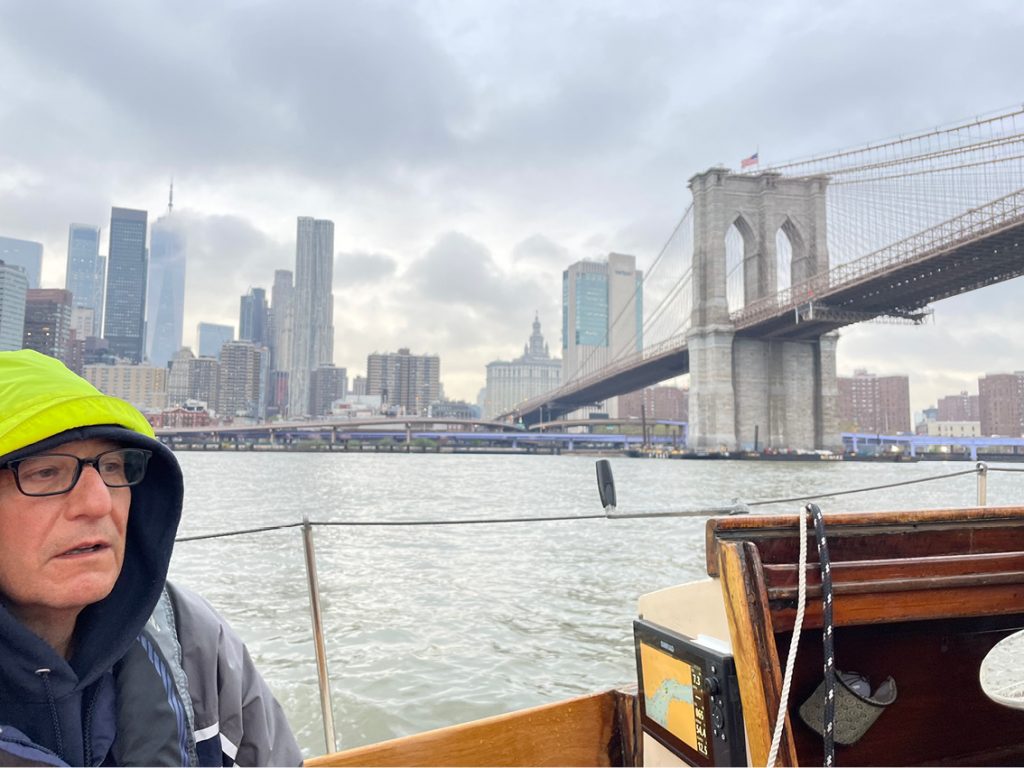
Former GC owner John Moreno looking pensive as we prepare to sail under the Brooklyn Bridge with the Manhattan skyline under heavy clouds.
Simple arithmetic indicated we would be stuck in this position until about 9:30 pm and would likely not float off until about 10 pm. In the meantime, the temperature – in May! – kept dropping until at about 9 pm I could see my own breath, was shivering, and my teeth began to chatter uncontrollably. I was inside a lightweight sleeping bag and was still distressingly cold. Finally, at 10:07 pm we floated free, powered to the gas dock and tied up. After multiple phone calls to arrange the correct meeting place and time, John’s wife and son arrived to take him back to Stony Point.
The next morning, we noticed the wind was still out of the NE. We started the Mercury outboard, and it did not sound at all well. It would run for a minute or two, sputter badly, almost stall, and repeat this cycle over and over again. A few times it did stall and was then especially difficult to restart. Realizing that we had an unreliable engine and that the winds were dead on the nose, we evaluated alternatives. Ultimately, we decided to sail for Westport, Connecticut. Fortunately, the 22-year-old 2-stroke engine lasted just long enough to enable us to dock on an end-tie at Ned Dimes Marina near Compo Beach. Now the real saga begins.
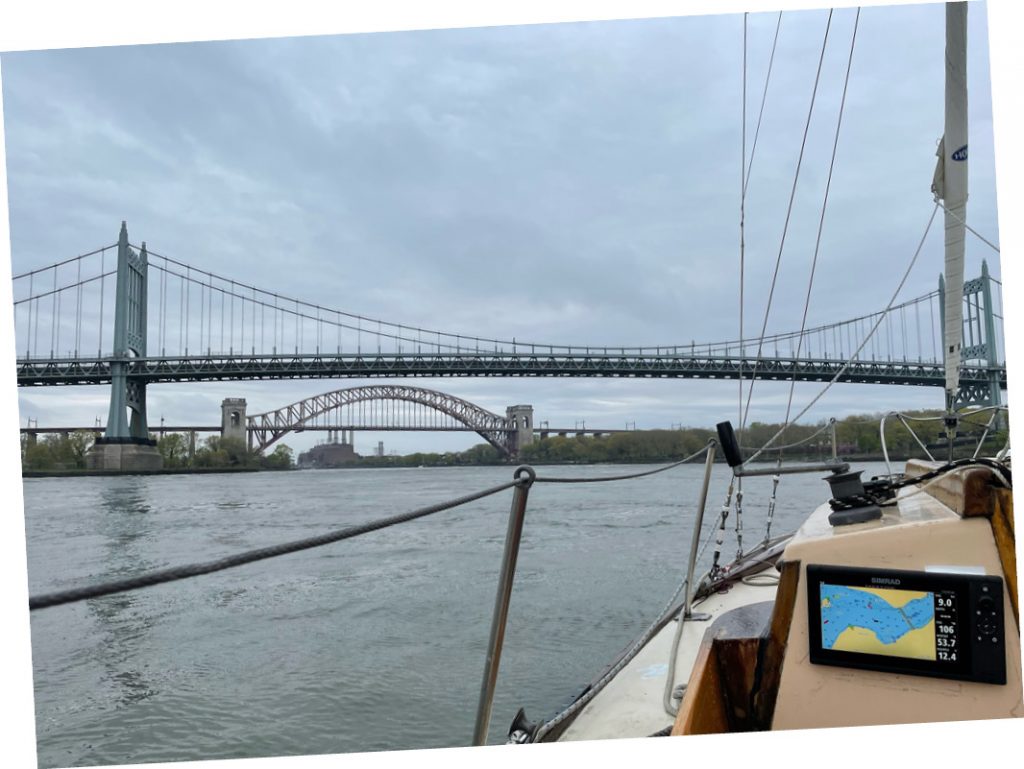
Motorsailing through Hell’s Gate, approaching the Robert F. Kennedy (formerly Triboro) Bridge, with the Hell’s Gate Railroad
The New Engine
The former outboard engine, as noted earlier, was a 22-year-old 9.9 HP Mercury which fit, albeit snugly in the engine well on the Constellation’s small afterdeck. Virtually all modern outboard engines are four-stroke units, which have larger cylinder heads for the same horsepower. After checking the dimensions of new outboards manufactured by Mercury, Tohatsu (which now makes and re-brands Mercury outboards), Honda, Nissan and Yamaha, it soon became distressingly apparent that NONE of the 9.9 HP outboards would fit in the engine well. While Tom and I do plan to restore the GC, we did NOT intend to perform major surgery on her engine well. Thus, nominal 10 HP outboards simply would not fit!
At this point we began looking into four-stroke 8 HP models. Amazingly, none of these would fit either. Concerned that the boat might be seriously underpowered, we had little choice but to investigate 6 HP outboards. Even there, a new 6 HP engine that would fit into the engine well was hardly a slam-dunk. Furthermore, after our experience with 6-foot head-seas, we really wanted an engine with an “extra-long” (25-inch) shaft.
Multiple internet inquiries and phone calls to suppliers of outboard engines throughout New England resulted in further frustration since we could not locate any with extra-long shafts. Finally, a friend suggested we call Defender in Waterford, Connecticut. They had exactly one Tohatsu, 6 HP extra-long shaft engine in stock! We left the GC securely tied to an end dock and drove two hours to Defender.
We were thrilled to confirm that Defender had a 6 HP Tohatsu outboard with an extra-long 25-inch shaft in their store but were devastated to discover that while Defender has a generous refund policy on almost all products they sell, conspicuous by exception is their policy regarding engines. Summarized simply, it dictates, “If you buy an engine, you own it. No refunds allowed.” Evidently, if it somehow did not fit in the GC’s engine well we would have a shiny, white, $1,800, 65-pound paperweight. What to do?
Then, I realized Nancy and I already owned a four-stroke, 4 HP Tohatsu outboard for our dinghy – to get us out to Pleiades and back, and to use while cruising. The extremely knowledgeable salesperson at Defender informed Tom and I that the 4 HP and 6 HP Tohatsu outboards are identical except for carburation and propellers. Thus, we drove home to Warwick, Rhode Island and the next day drove back to Westport (about 3.5 hours) with the 4 HP outboard and installed it in the GC engine well. It just barely fit, but the gearshift lever bumped into the mahogany well-surround when attempting to shift into forward! Fortunately, that problem was solved with a 3-inch diameter hole saw!
So, the next day we drove back to Defender, purchased a new 2022 four-stroke 6 HP Tohatsu “Sail Pro” outboard engine with an “extra-long” 25” shaft and a “high thrust” propeller, and drove back to Westport – yet again! After some twisting, pulling and pushing, and the use of a splendid “mini-crane” with a 5:1 block & tackle that John had provided with the GC, and only two or three profane utterances, our new engine was securely mounted in the GC engine well. Hallelujah!
The sad news was that our partnership checking account was now down $1,800, and our voyage had been delayed by ten days. On the other hand, our GC now has a brand-new engine, that consumes only 0.3 gallon per hour (vs. 1 gallon per hour for the former 2-stroke Mercury), it has an extra-long 25” shaft that puts the prop deeper in the water, and utterly amazingly – as it is only 6 HP vs. 9.9 for the former engine – subsequently pushed the GC along just under hull speed in flat water while running at only half-throttle, as is required by the manufacturer during the engine’s initial break-in period.
The next morning we were trying to find some place to have a warm cup of coffee. It was raining, and while walking in the marina Tom and I must have looked like a pair of bedraggled old men. A car came slowly along the marina road and feeling gutsy, I stepped in front and used the “palm forward” universal stop sign. The vehicle stopped. I walked up to the driver and asked in my most pathetic voice, “Can you kindly help two old fellows trying to find a coffee shop?” Note that this was a mother with an infant and a live-in babysitter inside, being stopped by two strangers. Perhaps I have an honest looking face. She kindly not only asked us both to get in out of the rain, but drove us to a nice coffee shop. She said she needed to take the baby and nanny home, but would be back in fifteen minutes to have coffee with us, and then drive us back to the marina! Her name was Mina, she personified kindness, and we later thanked her via e-mail.
The going rate for a transient slip at the very neat and clean Ned Dimes Marina was between $100 and $140 per night. The manager must have also taken pity on us, because although the GC was there for ten nights, he had heard about our engine issue and only charged us for two nights. The kindness of strangers is often amazing, and always welcome. ■
Look for the conclusion of The Saga in our next issue



